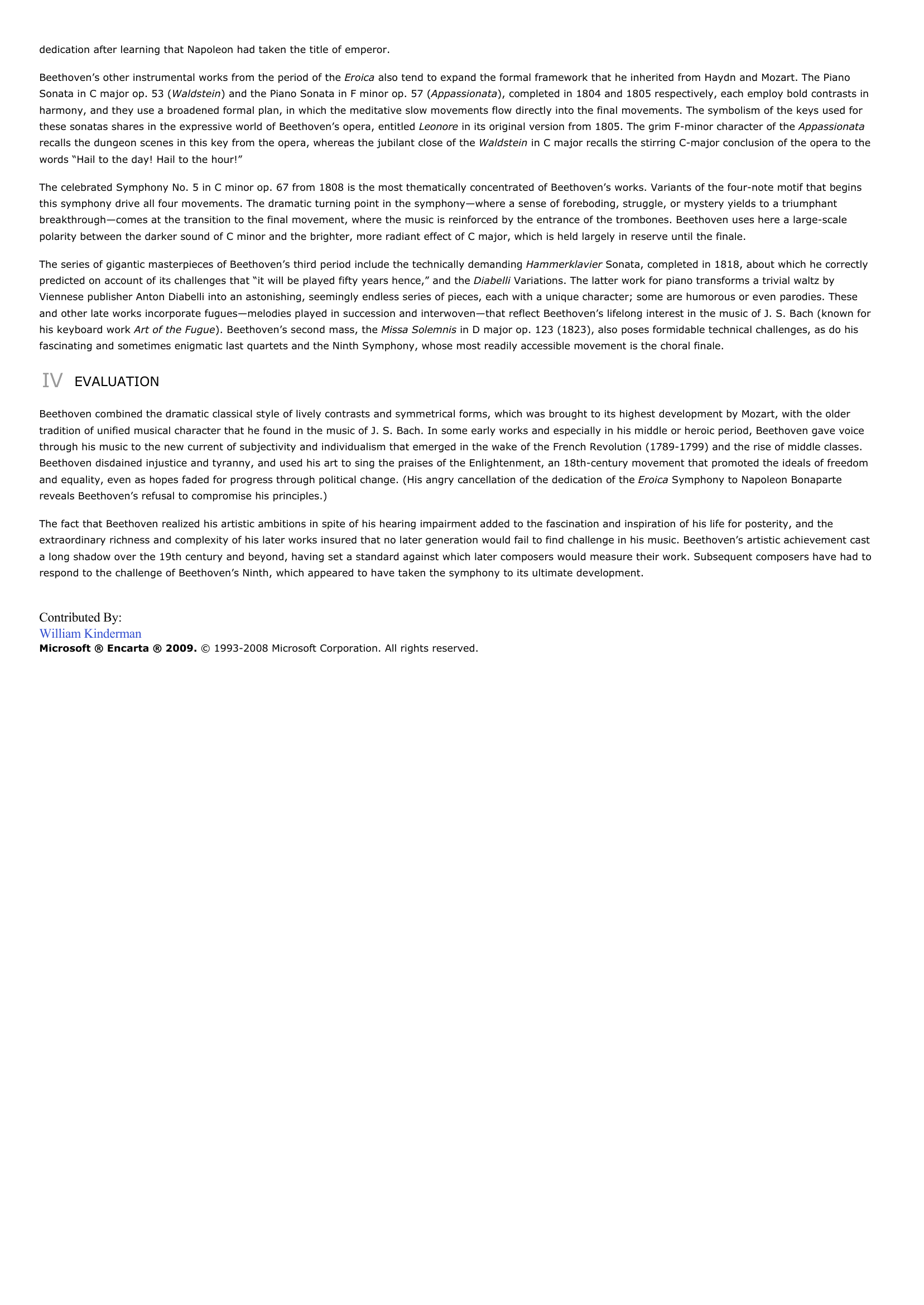Ludwig van Beethoven I INTRODUCTION Ludwig van Beethoven (1770-1827), German composer, considered one of the greatest musicians of all time.
Publié le 10/05/2013

Extrait du document
«
dedication after learning that Napoleon had taken the title of emperor.
Beethoven’s other instrumental works from the period of the Eroica also tend to expand the formal framework that he inherited from Haydn and Mozart.
The Piano Sonata in C major op.
53 ( Waldstein ) and the Piano Sonata in F minor op.
57 ( Appassionata ), completed in 1804 and 1805 respectively, each employ bold contrasts in harmony, and they use a broadened formal plan, in which the meditative slow movements flow directly into the final movements.
The symbolism of the keys used forthese sonatas shares in the expressive world of Beethoven’s opera, entitled Leonore in its original version from 1805.
The grim F-minor character of the Appassionata recalls the dungeon scenes in this key from the opera, whereas the jubilant close of the Waldstein in C major recalls the stirring C-major conclusion of the opera to the words “Hail to the day! Hail to the hour!”
The celebrated Symphony No.
5 in C minor op.
67 from 1808 is the most thematically concentrated of Beethoven’s works.
Variants of the four-note motif that beginsthis symphony drive all four movements.
The dramatic turning point in the symphony—where a sense of foreboding, struggle, or mystery yields to a triumphantbreakthrough—comes at the transition to the final movement, where the music is reinforced by the entrance of the trombones.
Beethoven uses here a large-scalepolarity between the darker sound of C minor and the brighter, more radiant effect of C major, which is held largely in reserve until the finale.
The series of gigantic masterpieces of Beethoven’s third period include the technically demanding Hammerklavier Sonata, completed in 1818, about which he correctly predicted on account of its challenges that “it will be played fifty years hence,” and the Diabelli Variations.
The latter work for piano transforms a trivial waltz by Viennese publisher Anton Diabelli into an astonishing, seemingly endless series of pieces, each with a unique character; some are humorous or even parodies.
Theseand other late works incorporate fugues—melodies played in succession and interwoven—that reflect Beethoven’s lifelong interest in the music of J.
S.
Bach (known forhis keyboard work Art of the Fugue ).
Beethoven’s second mass, the Missa Solemnis in D major op.
123 (1823), also poses formidable technical challenges, as do his fascinating and sometimes enigmatic last quartets and the Ninth Symphony, whose most readily accessible movement is the choral finale.
IV EVALUATION
Beethoven combined the dramatic classical style of lively contrasts and symmetrical forms, which was brought to its highest development by Mozart, with the oldertradition of unified musical character that he found in the music of J.
S.
Bach.
In some early works and especially in his middle or heroic period, Beethoven gave voicethrough his music to the new current of subjectivity and individualism that emerged in the wake of the French Revolution (1789-1799) and the rise of middle classes.Beethoven disdained injustice and tyranny, and used his art to sing the praises of the Enlightenment, an 18th-century movement that promoted the ideals of freedomand equality, even as hopes faded for progress through political change.
(His angry cancellation of the dedication of the Eroica Symphony to Napoleon Bonaparte reveals Beethoven’s refusal to compromise his principles.)
The fact that Beethoven realized his artistic ambitions in spite of his hearing impairment added to the fascination and inspiration of his life for posterity, and theextraordinary richness and complexity of his later works insured that no later generation would fail to find challenge in his music.
Beethoven’s artistic achievement casta long shadow over the 19th century and beyond, having set a standard against which later composers would measure their work.
Subsequent composers have had torespond to the challenge of Beethoven’s Ninth, which appeared to have taken the symphony to its ultimate development.
Contributed By:William KindermanMicrosoft ® Encarta ® 2009. © 1993-2008 Microsoft Corporation.
All rights reserved..
»
↓↓↓ APERÇU DU DOCUMENT ↓↓↓
Liens utiles
- Ludwig van Beethoven I INTRODUCTION Ludwig van Beethoven Ludwig van Beethoven is considered possibly the greatest Western composer of all time.
- Wolfgang Amadeus Mozart I INTRODUCTION Wolfgang Amadeus Mozart Wolfgang Amadeus Mozart, an 18th-century Austrian classical composer and one of the most famous musicians of all time, came from a family of musicians that included his father and sister.
- Johann Sebastian Bach I INTRODUCTION Johann Sebastian Bach (1685-1750), German composer and one of the world's greatest musical geniuses.
- Duke Ellington Duke Ellington (1899-1974), American jazz composer, orchestrator, bandleader, and pianist, considered the greatest composer in the history of jazz music and one of the greatest musicians of the 20th century.
- Isaac NewtonIINTRODUCTIONIsaac Newton (1642-1727), English physicist, mathematician, and natural philosopher, considered one of the most important scientists of all time.

































